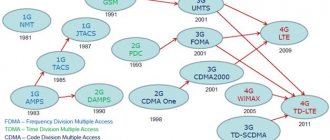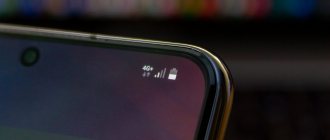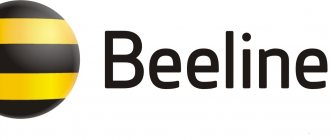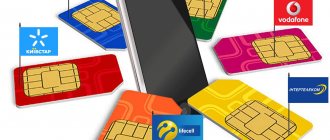Rating: 4.3/5 — 22 votes
A little more than 15 years have passed since the launch of Russia's first cellular gsm network into commercial operation, which today a business person simply cannot do without. The era of cellular communications began, which gradually began to displace landline phones. Mobile operator companies, in addition to voice services, began to provide data services. Of course, it is still too early to talk about a complete abandonment of wired access, but at a minimum, it is necessary to talk about its alternative - mobile Internet.
Residents of large cities are familiar with the terms Ethernet and xDSL; it is through these technologies that the majority of broadband Internet connections are made in large Russian cities. From the point of view of global network users, these technologies undoubtedly have a number of advantages. They provide high speed and reliable connections, and at the same time are affordable. For Muscovites, unlimited Internet at speeds of tens of Mbit/s costs 300-1000 rubles per month.
Today, the trend of technological progress in the field of mobile Internet and wireless data transmission technologies , which are firmly part of our lives, is already clearly visible and perhaps in the near future, wireless Internet will play its role, just as mobile communications once played their role with wired phones. However, if mobile communications in our country have undergone rapid development, then, unfortunately, things are not so bright with wireless Internet access.
Cellular.
Also on topic:
PHONE
The most common type of mobile communication today is cellular communication. Cellular communication services are provided to subscribers by operator companies.
A network of base stations provides wireless communication to a cell phone.
Also on topic:
INTERNET
Each station provides access to the network in a limited area, the area and configuration of which depends on the terrain and other parameters. The overlapping coverage areas create a honeycomb-like structure; The term “cellular communication” comes from this image. When a subscriber moves, his phone is served by one or another base station, and the switching (cell change) occurs automatically, completely unnoticed by the subscriber, and does not in any way affect the quality of communication. This approach allows, using low-power radio signals, to cover large areas with a mobile communications network, which provides this type of communication, in addition to efficiency, also a high level of environmental friendliness.
Also on topic:
ELECTRONICS INDUSTRY
The operator company not only technically provides mobile communications, but also enters into economic relationships with subscribers who purchase from it a certain set of basic and additional services. Since there are quite a lot of types of services, prices for them are combined into sets called tariff plans. The cost of services provided to each subscriber is calculated by the billing system (a hardware and software system that keeps records of the services provided to the subscriber).
The operator's billing system interacts with similar systems of other companies, for example, those providing roaming services to the subscriber (the ability to use mobile communications in other cities and countries). The subscriber makes all mutual payments for mobile communications, including in roaming, with his operator, which is a single settlement center for him.
Roaming is access to mobile communication services outside the coverage area of the “home” operator’s network with which the subscriber has a contract.
While roaming, the subscriber usually retains his phone number and continues to use his cell phone, making and receiving calls in the same way as on the home network. All actions necessary for this, including inter-operator traffic exchange and attracting the resources of other communication companies (for example, providing transcontinental communications) as necessary, are carried out automatically and do not require additional actions from the subscriber. If the home and guest networks provide communication services in different standards, roaming is still possible: the subscriber can be given a different device for the duration of the trip, while maintaining his phone number and automatically routing calls.
"Z"
Call barring is a service that allows you to restrict incoming or outgoing calls. The ban can be on all incoming, all outgoing or international calls. The function is used infrequently.
The coverage area of a telecom operator is the territory in which the operator guarantees the provision of communication services. The coverage area does not always coincide with the coverage area (the territory in which, in principle, you can use cellular communication services. This does not include the territory in which roaming is provided).
History of cellular communications.
Work on the creation of civilian mobile communication systems began in the 1970s. By this time, the development of conventional telephone networks in European countries had reached such a level that the next step in the evolution of communications could only be the availability of telephone communications anywhere and everywhere.
Networks based on the first civilian cellular standard, NMT-450, appeared in 1981. Although the name of the standard is an abbreviation of the words Nordic Mobile Telephony (“mobile telephony of the Nordic countries”), the first cellular network on the planet was deployed in Saudi Arabia. In Sweden, Norway, Finland (and other Nordic countries), NMT networks went live several months later.
Two years later - in 1983 - the first network of the AMPS (Advanced Mobile Phone Service) standard, created at the Bell Laboratories research center, was launched in the United States.
The NMT and AMPS standards, which are generally considered to be the first generation of cellular communication systems, provided for data transmission in analog form, which did not allow for the proper level of noise immunity and protection from unauthorized connections. Subsequently, they developed modifications improved through the use of digital technologies, for example, DAMPS (the first letter of the abbreviation owes its appearance to the word Digital).
The second generation standards (the so-called 2G) - GSM, IS-95, IMT-MC-450, etc., initially created on the basis of digital technologies, exceeded the first generation standards in sound quality and security, and also, as it turned out later, in the underlying to the standard of development potential.
Already in 1982, the European Conference of Postal and Telecommunications Administrations (CEPT) created a group to develop a common standard for digital cellular communications. The brainchild of this group was GSM (Global System for Mobile Communications).
The first GSM network was launched in Germany in 1992. Today, GSM is the dominant cellular communication standard both in Russia and throughout the world. In 2004, in our country, GSM networks served over 90% of cellular subscribers; in the world GSM was used by 72% of subscribers.
Several frequency ranges are allocated for the operation of GSM standard equipment - they are indicated by numbers in the names. In the European region, GSM 900 and GSM 1800 are mainly used, in America - GSM 950 and GSM 1900 (at the time the standard was approved in the USA, the “European” frequencies there were occupied by other services).
The popularity of the GSM standard was ensured by its significant features for subscribers:
– high quality voice transmission;
– protection from interference, interception and “doubles”;
– availability of a large number of additional services;
– the ability, in the presence of “add-ons” (such as GPRS, EDGE, etc.), to provide data transmission at high speeds;
– presence on the market of a large number of telephones operating in GSM networks;
– simplicity of the procedure for changing one device to another.
In the process of development, GSM cellular networks have acquired the ability to expand due to some “add-ons” over the existing infrastructure, providing high-speed data transfer. GSM networks supporting GPRS (General Packet Radio Service) are called 2.5G, and GSM networks supporting EDGE (Enhanced Data rates for Global Evolution) are sometimes called 2.75G networks.
In the late 1990s, third generation (3G) networks appeared in Japan and South Korea. The main difference between the standards on which 3G networks are built and their predecessors is the expanded capabilities of high-speed data transmission, which allows the implementation of new services in such networks, in particular, video telephony. In 2002–2003, the first commercial 3G networks began operating in some Western European countries.
Although 3G networks currently exist only in a number of regions of the world, work is already underway in the engineering laboratories of the largest companies to create fourth-generation cellular communication standards. At the forefront of this is not only a further increase in data transmission speed, but also an increase in the efficiency of using the capacity of frequency bands allocated for mobile communications, so that a large number of subscribers located in a limited area can access services (which is especially important for megacities) .
3G
The factors listed above have led to the emergence of third generation systems (3G, 1999), which allow communication, information exchange and the provision of various entertainment services focused on a wireless terminal device. The development of such services has already begun for 2G systems, but to support these services, the system must have high capacity and radio throughput, as well as compatibility between systems to provide transparent access around the world. An example of a 3G system is UMTS (Universal Mobile Telecommunications System). This standard allows you to provide subscribers with data transfer rates of up to 2 Mbit/s. HSDPA (3.5G) technology gives speeds of up to 14 Mbit/s. Thus, network users can receive a wide range of multimedia services (high-quality video, games, downloading large files). However, even this data transfer rate will satisfy the needs of the network user only to certain limits. In this regard, the development of a fourth generation standard has begun, which will remove the upper limit for a long time.
Thus, in less than 30 years, cellular communication technology has come a long way. Now the subscriber no longer feels geographically tied and can use high-quality telecommunications services wherever he is. There was a change in the basic idea, a shift from voice networks to data networks, and voice became just one of the services of the data network.
In the next five years, the implementation of the concept of the “Internet of Services” can transform the market for M2M (Machine-to-Machine, machine-to-machine communication) services from a secondary one for telecom operators into a key one, just as the market for voice services is now for them.
Other mobile communication systems.
In addition to cellular communications, today there are other civil communication systems that also provide mobile communications via radio channels, but are built on different technical principles and are aimed at other subscriber terminals. They are less common than cellular communications, but are used when using cellular phones is difficult, impossible or economically unviable.
The DECT microcellular communication standard, which is used for communications in a limited area, is becoming increasingly popular. A DECT base station is capable of providing handsets (up to 8 of them can be serviced simultaneously) with each other, call forwarding, and access to the public telephone network. The potential of the DECT standard makes it possible to provide mobile communications within urban neighborhoods, individual companies or apartments. They turn out to be optimal in regions with low-rise buildings, whose subscribers only need voice communications and can do without mobile data transmission and other additional services.
In satellite telephony, base stations are located on satellites in low-Earth orbits. Satellites provide communications where the deployment of a conventional cellular network is impossible or unprofitable (at sea, in vast sparsely populated areas of tundra, deserts, etc.).
Trunking networks, which provide subscriber terminals (they are usually called not telephones, but radio stations) with communication within a certain territory, are systems of base stations (repeaters) that transmit radio signals from one terminal to another when they are significantly removed from each other. Since trunking networks usually provide communication to employees of departments (Ministry of Internal Affairs, Ministry of Emergency Situations, Ambulance, etc.) or at large technological sites (along highways, at construction sites, on the territory of factories, etc.), trunking terminals do not have entertainment capabilities and design delights in decoration.
Wearable radios communicate with each other directly, without intermediate communication systems. Mobile communications of this type are preferred by both government (police, fire brigade, etc.) and departmental structures (for communications within a warehouse complex, parking lot or construction site), and private individuals (mushroom pickers, fishermen or tourists), in situations , when it is easier and cheaper to use pocket radios to communicate with each other than cell phones (for example, in remote areas where there is no cellular network coverage).
Paging communication ensures the receipt of short messages to subscriber terminals - pagers. Currently, paging communications are practically not used in civil communications; due to their limitations, they are pushed into the field of highly specialized solutions (for example, they are used to notify personnel in large medical institutions, transmit data to electronic information boards, etc.).
Since 2004, a new subtype of mobile communication has become increasingly widespread, providing the possibility of high-speed data transmission over a radio channel (in most cases, the Wi-Fi protocol is used for this). Areas with Wi-Fi coverage available for public use (paid or free) are called hotspots. In this case, the subscriber terminals are computers - both laptops and PDAs. They can also provide two-way voice communication over the Internet, but this feature is used extremely rarely; the connection is mainly used to access the most common Internet services - email, websites, instant messaging systems (for example, ICQ), etc. .
Where is mobile communications going?
In developed regions, the main direction of development of mobile communications for the near future is convergence: providing subscriber terminals with automatic switching from one network to another in order to most effectively use the capabilities of all communication systems. Automatic switching, for example, from GSM to DECT (and vice versa), from satellite to terrestrial communications, and when providing wireless data transmission, will allow automatic switching, for example, between GPRS, EDGE, Wi-Fi and other standards, many of which (for example, WiMAX) are just waiting in the wings.
1G
The first generation systems (1G, 1981) were analog, implemented on fairly reliable networks, but with a limited ability to offer services to subscribers. In addition, they did not allow roaming between networks, i.e. subscribers with one SIM card could not receive services in the networks of different operators. The first generation systems include: AMPS and NMT, which were later almost completely replaced by the GSM standard. Disadvantages - lack of security (the channel was easy to listen to), difficulties with roaming, low capacity, long range (about 30 km), which in a metropolis is a disadvantage that makes it difficult to reuse frequencies.
The place of mobile communications in the global economy.
Communications are the most dynamically developing sector of the world economy. But mobile communications, even compared to other areas of telecom, are developing at a faster pace.
Back in 2003, the total number of mobile phones on the planet exceeded the number of landline devices connected to public wired networks. In some countries, the number of mobile subscribers already exceeded the number of inhabitants in 2004. This means that some people used more than one “mobile”—for example, two cell phones with different carriers, or a voice phone and a wireless modem for mobile Internet access. In addition, more and more wireless communication modules were required to provide technological communications (in these cases, the subscribers are not people, but specialized computers).
Currently, cellular operators provide full coverage of the territory of all economically developed regions of the planet, but the extensive development of networks continues. New base stations are installed to improve reception in places where the existing network for some reason cannot provide stable reception (for example, in long tunnels, in metro areas, etc.). In addition, cellular networks are gradually penetrating into low-income regions. The development of mobile communication technologies, accompanied by a sharp reduction in the cost of equipment and services, makes cellular services accessible to an increasing number of people on the planet.
The production of cell phones is one of the most dynamically developing areas of the high technology industry.
The mobile phone servicing industry is also growing rapidly, offering accessories for personalizing devices: from original calls (ringtones) to key fobs, graphic screensavers, body stickers, replacement panels, cases and cords for wearing the device.
Satellite Internet
The coverage radius of this type of connection is the widest of all possible, thanks to which you can use the Internet anywhere in the world. However, satellite Internet remained not particularly in demand for several reasons. Firstly, this type of connection provides one-way access, i.e., information transfer is only possible from the Network to the user, there is no return transfer. Secondly, this type of connection has relatively low reliability and depends on meteorological conditions. If the satellite gets into the “shadow zones,” the connection deteriorates sharply or disappears altogether. There are other disadvantages - for example, very expensive connection equipment, high cost of use, low response speed. Therefore, this type of connection can only be chosen if you live far from civilization and there is simply no other way. Find out more about satellite Internet from Wi-Fi House
Types of phones.
Cellular (mobile) phone is a subscriber terminal operating in a cellular network. In fact, each cell phone is a specialized computer, which is focused primarily on providing (in the coverage area of a home or guest network) voice communication for subscribers, but also supports the exchange of text and multimedia messages, is equipped with a modem and a simplified interface. Modern mobile phones provide voice and data transmission in digital form.
The earlier division of devices into “inexpensive”, “functional”, “business” and “fashion” models is increasingly losing its meaning - business devices acquire the features of image models and entertainment functions; as a result of the use of accessories, inexpensive phones become fashionable, while fashionable ones functionality is growing rapidly.
The miniaturization of handsets, which peaked in 1999–2000, ended for quite objective reasons: the devices have reached an optimal size, their further reduction makes it inconvenient to press buttons, read text on the screen, etc. But the cell phone has become a real object of art: leading designers are involved in developing the appearance of the devices, and owners are given ample opportunities to personalize their devices themselves.
Currently, manufacturers are paying special attention to the functionality of mobile phones, both basic (increasing battery life, improving screens, etc.) and their additional capabilities (digital cameras, voice recorders, MP3 players and other “related” devices are built into the devices). » devices).
Almost all modern devices, with the exception of some models in the lower price range, allow you to download programs. Most devices can run Java applications, and the number of phones using operating systems inherited from PDAs or ported from them is increasing: Symbian, Windows Mobile for Smartphones, etc. Phones with built-in operating systems are called smartphones (from the combination of the English words “smart” and “phone” - “smart phone”).
Today, communicators can also be used as subscriber terminals - pocket computers equipped with a module supporting GSM/GPRS, and sometimes EDGE and third generation standards.
Non-voice services of cellular networks.
Cellular network subscribers have access to a whole range of non-voice services, the “range” of which depends on the capabilities of a particular phone and the range of offers of the operator company. The list of services in your home network may differ from the list of services available in roaming.
Services can be communication (providing various forms of communication with other people), informational (for example, reporting on weather forecasts or market quotes), providing access to the Internet, commercial (for paying for various goods and services from phones), entertainment (mobile games, quizzes) , casinos and lotteries) and others (this includes, for example, mobile positioning). Today, more and more services are appearing that are “at the intersection”, for example, most games and lotteries are paid, games using mobile positioning technologies are appearing, etc.
Almost all operators and most modern devices support the following services:
– SMS – Short Message Service – transmission of short text messages;
– MMS – Multimedia Messaging Service – transmission of multimedia messages: photos, videos, etc.;
– automatic roaming;
– identification of the calling subscriber number;
– voice mail – saving voice and text messages transmitted while the subscriber was out of the access area;
– ordering and receiving various means of personalization directly via cellular communication channels;
– access to the Internet and view specialized (WAP) sites;
– downloading ringtones, pictures, information materials from specialized resources;
– data transfer using the built-in modem (it can be carried out using various protocols depending on what technologies a particular device supports).
LTE
The LTE (Long Term Evolution) system was developed to provide users with access to all kinds of services, as well as to the Internet via the IP protocol. An LTE network consists of many nodes. All network nodes are usually divided into two categories: nodes related to the radio access network (Radio Access) and nodes of the core network (Core Network). The key element that determines the effectiveness of any radio network is the algorithms and mechanisms used to transfer data between the BS and the MS. The following describes the main characteristics of the LTE network related to the radio access network.
According to the requirements for the LTE system, with a cell radius of up to 5 km, all parameters of spectral efficiency, throughput and work with mobile subscribers must be supported. For a cell radius of 5 to 30 km, performance degradation is acceptable.
To ensure bidirectional data transmission between BS and MS, LTE technology supports both frequency duplex (FDD) and time duplex (TDD). For frequency duplex, 15 paired frequency ranges are defined (frequencies from 800 MHz to 3.5 GHz), and for time duplex - eight. In this case, the width of the radio channel can be different. Valid values are: 1.4/3/5/10/15/20 MHz.
LTE uses OFDMA (Orthogonal Frequency Division Multiple Access) in the downlink and SC-FDMA (Single Carrier Frequency Division Multiple Access) in the uplink as multiple access systems. When using OFDMA technology, the entire available spectrum is divided into subcarriers orthogonal to each other. Depending on the channel width used, the total number of subcarriers can be 72, 180, 300, 600, 900 or 1200. Each subcarrier can have its own type of modulation. The following modulations can be used: QPSK, 16QAM, 64QAM.
Multiple access is organized due to the fact that one part of the subcarriers is allocated to one user in the frame, the other part to the second, etc. The LTE standard (namely, 3GPP TS 36.306) defines a total of 15 (document version dated March 27, 2015) categories of mobile devices . The mobile device category specifies the maximum transmission rates in DL and UL. Table 2 lists the bit rates, supported MIMO (Multiple Input Multiple Output) configurations, and modulation types for each category.
Table 2 . Baud rates, supported MIMO configurations and modulation types
| UE category | Downlink | Uplink | ||||
| Maximum number of bits in TTI | Maximum number of bits in a transport block | MIMO | 64QAM support | Maximum number of bits in a transport block | ||
| 0 | 1000 | 1000 | – | – | 1000 | |
| 1 | 10296 | 10296 | – | – | 5160 | |
| 2 | 51024 | 51024 | 2×2 | – | 25456 | |
| 3 | 102048 | 75376 | 2×2 | – | 51024 | |
| 4 | 150752 | 75376 | 2×2 | – | 51024 | |
| 5 | 299552 | 149776 | 2×2, 4×4 | + | 75376 | |
| 6 | 301504 | 149776 (4×4) 75376 (2×2) | 2×2, 4×4 | – | 51024 | |
| 7 | 301504 | 149776 (4×4) 75376 (2×2) | 2×2, 4×4 | – | 102048 | |
| 8 | 2998560 | 299856 | 8×8 | + | 1497760 | |
| 9 | 452256 | 149776 (4×4) 75376 (2×2) | 2×2, 4×4 | – | 51024 | |
| 10 | 452256 | 149776 (4×4) 75376 (2×2) | 2×2, 4×4 | – | 102048 | |
| 11 | 603008 | 149776 (4×4.64QAM)195816 (4×4, 256QAM) 75376 (2×2, 64QAM)97896 (2×2, 256QAM) | 2×2, 4×4 | – | 51024 | |
| 12 | 603008 | 149776 (4×4.64QAM)195816 (4×4, 256QAM) 75376 (2×2, 64QAM)97896 (2×2, 256QAM) | 2×2, 4×4 | – | 102048 | |
| 13 | 391632 | 195816 (4×4) 97896 (2×2) | 2×2, 4×4 | + | 150752 | |
| 14 | 3916560 | 391656 | 8×8 | + | 1497760 | |
| 15 | 749856–798800 | 149776 (4×4.64QAM)195816 (4×4, 256QAM) 75376 (2×2, 64QAM)97896 (2×2, 256QAM) | 2×2, 4×4 | n/a | n/a | |
| 16 | 978960–1051360 | 149776 (4×4.64QAM) 195816 (4×4, 256QAM) 97896 (2×2, 256QAM) | 2×2, 4×4 | n/a | n/a | |
Using the above values, you can roughly calculate the maximum transfer speed. In the downlink channel, the maximum transmission speed values, depending on the category of the mobile station, will be as follows: 10, 50, 100, 150, 300, 300, 300 Mbit/s and 3 Gbit/s. For the uplink the following values are obtained: 5, 25, 50, 50, 75, 50, 100 Mbps and 1.5 Gbps. In Fig. Figure 5 shows the distribution of “down” and “up” speeds by LTE category.
Mobile devices of all categories support channel widths up to 20 MHz (except category 0) and 64QAM modulation (except category 0) in the downstream channel. Category 0 is introduced specifically for MTC (Machine Type Communications). One of the main requirements within MTC is very low power consumption. Hence the strict restrictions on the supported set of functions at the physical level and the buffer size.
The main advantage of OFDMA technology is that it allows you to combat the negative effects caused by multipath propagation when receiving a signal. However, this technology also has some disadvantages. The main ones are that this technology is very sensitive to frequency synchronization. The generated OFDMA signal has a high PAPR (Peak to Average Ratio). This, in turn, affects the fact that the signal amplifier used will operate in nonlinear sections of its characteristics. Therefore, its efficiency will be low, which is quite critical for devices with limited energy reserves (mobile terminals). Because of this, the LTE uplink uses a different multiple access technology, namely SC-FDMA. The difference between SC-FDMA and OFDMA is that SC-FDMA uses additional signal processing to reduce PAPR. SC-FDMA uses the Fourier transform as such additional signal processing. The uplink can use different types of modulation: QPSK, 16QAM, 64QAM.
The LTE standard also supports MIMO transmission technology, which can significantly increase the peak data rate and spectral efficiency value. The essence of MIMO technology is that several antennas are used on each side when transmitting and receiving data. Different antennas can transmit the same data, in which case the reliability of data transmission increases, but not the transmission speed. Also, different antennas can transmit different data streams, thereby increasing the data transfer rate. The maximum LTE technology supports in the downlink channel is 44. This means that four antennas are used on the transmitting and receiving sides. In this case, the data rate can be increased by up to four times (actually slightly less due to the increase in the number of pilot signals).
Using MIMO technology and a channel width of 20 MHz, the maximum data transfer rate can reach 300 Mbit/s in the downstream channel and 170 Mbit/s in the upstream channel.
The LTE requirements specify spectral efficiency values as 5 bps/Hz for the downlink and 2.5 bps/Hz for the uplink (corresponding to data rates of 100 Mbps and 50 Mbps). At the same time, high performance levels must be maintained for mobile users moving at speeds of up to 120 km/h.











